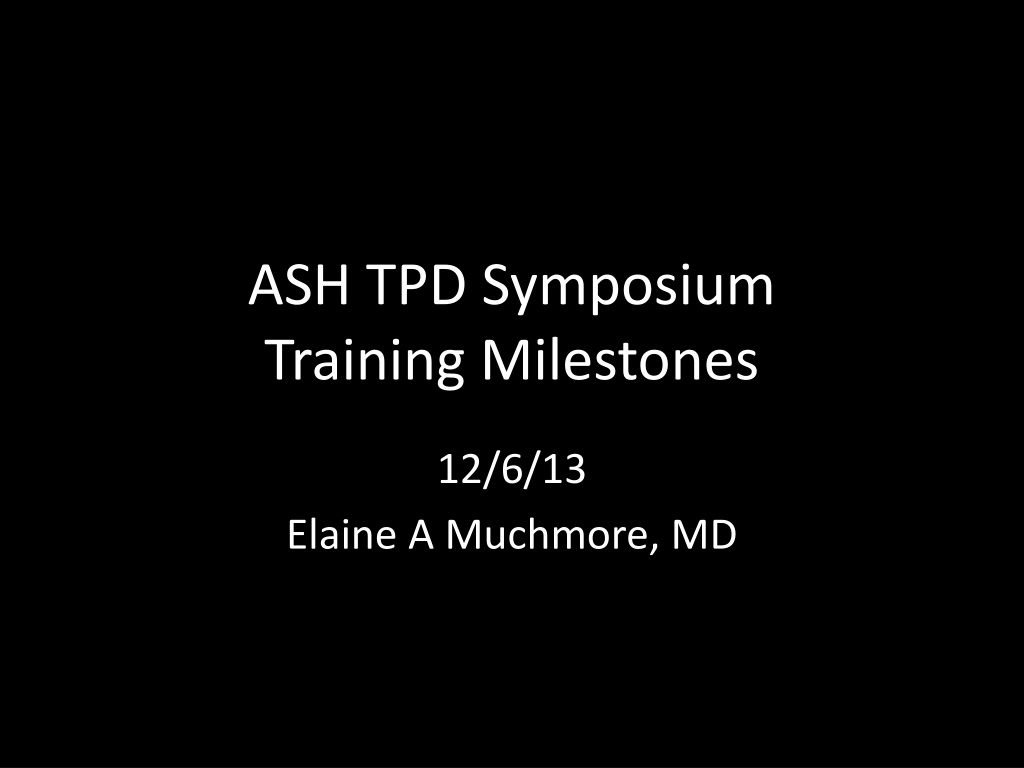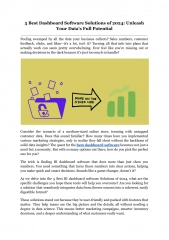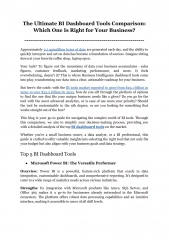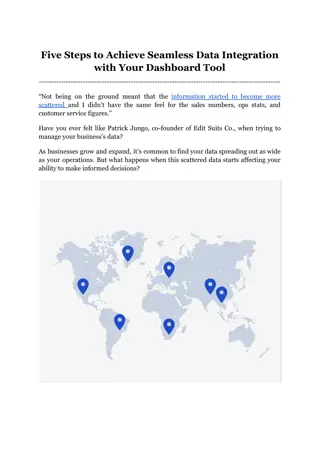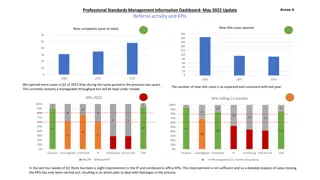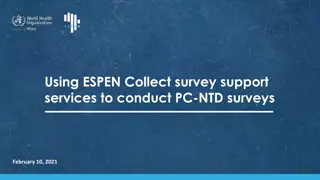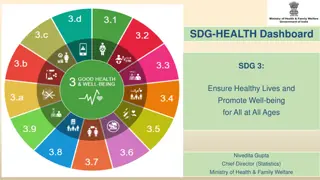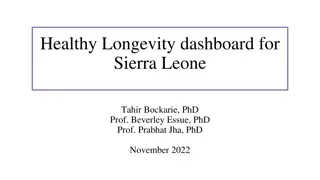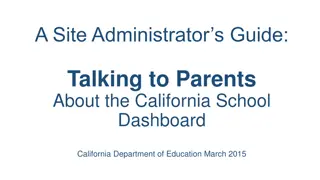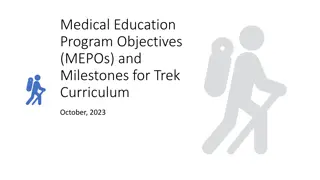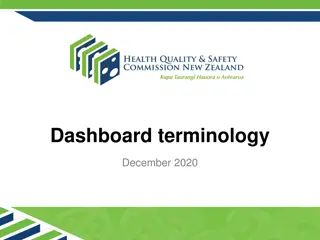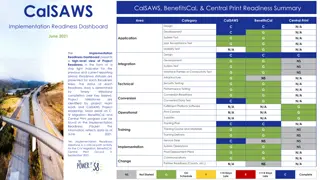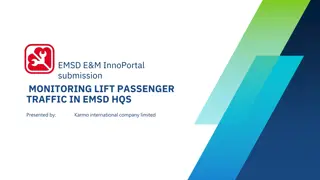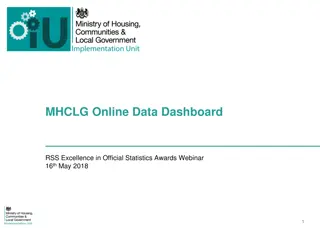Overview of Reporting Milestones and Dashboard Elements in Medical Training
This content provides detailed information on the timeline, goals, and implementation of reporting milestones for medical training programs, specifically focusing on the Hematology/Oncology specialty. It also discusses the annual data review elements, self-reported milestones, and the challenges in training interactions with residents and fellows. The content emphasizes the importance of evaluating program outcomes and adapting to changes in accreditation standards.
- Medical Training
- Reporting Milestones
- Hematology/Oncology
- Dashboard Elements
- Accreditation Standards
Download Presentation

Please find below an Image/Link to download the presentation.
The content on the website is provided AS IS for your information and personal use only. It may not be sold, licensed, or shared on other websites without obtaining consent from the author. Download presentation by click this link. If you encounter any issues during the download, it is possible that the publisher has removed the file from their server.
E N D
Presentation Transcript
ASH TPD Symposium Training Milestones 12/6/13 Elaine A Muchmore, MD
Conflicts of Interest Serve as H/O representative on RRC-Internal Medicine (term 2012-2018) Serve as ASH representative to AAIM/ABIM/ACGME Subspecialty Milestones Working Group
Goals of session Time-line for roll-out of reporting milestones for specialties Changes required to collate and submit fellow- specific information to ACGME Status and rationale for curricular milestones for Hematology/Oncology
Time-line for NAS/IM reporting milestones 1999: introduction of 6 areas of competence 2009: restructuring of accreditation based on training outcomes 2012: lengthening of accreditation cycles; identification of NAS phase 1 and phase 2 specialties 2012-2013: annual data input into webads by programs Early 2013: IM (reporting) specialty milestones posted for residencies 6/2013: formation of Clinical Competency Committees for phase 1 residencies 5/2014: First annual submission of evaluations of all residents in each of 22 subcompetencies; then twice yearly
Annual Data Review Elements (aka Dashboard ) for Fellowships RRC-IM will annually review: Collected now as part of the program s annual ADS update. ADS streamlined 2012: 33 fewer questions & more multiple choice or Y/N 1) Program Attrition 2) Program Changes 3) Scholarly Activity 4) Board Pass Rate 5) Clinical Experience 6) Resident Survey 7) Faculty Survey 8) Reporting Milestones Starting fall, 2013, will be self reported To be generated via annual administration of survey of graduating fellows Annual survey of >70% of fellows in program First conducted 2013
If only one part of dashboard, why all the angst about reporting milestones? Incremental increase in complexity of evaluations Require a sea change in training interactions with residents/fellows Require more time to complete No data regarding outcomes has been shared Compressed implementation time-line
Time-line for subspecialty reporting milestones 2/13: AAIM/ACGME/ABIM summit of specialty society representatives 5/13: Second summit. Decision: to add milestone for scholarship (MK3), and to split into writing groups to revise IM document 11/13: Third summit. Decision: 1) add PC4a (non-invasive procedures), but not to combine ANY of the IM milestones (new total 24) 2) all specialty fellowships will share same reporting milestones 12/3/13: final document sent to specialty societies 12/20/13: deadline for approval/disapproval 11/2014: first data will be submitted to ACGME for fellows, according to 24 reporting milestones
SUBSPECIALTY MILESTONES ACGME Report Worksheet 1. Gathers and synthesizes essential and accurate information to define each patient s clinical problem(s). (PC1) Ready for unsupervised practice Not Yet Assessable Critical Deficiencies Aspirational Comments:
23. (INTERNAL MEDICINE) Appropriate utilization and completion of health records. (ICS3) Ready for unsupervised practice Health records are organized, accurate, comprehensive, and effectively communicate clinical reasoning Not Yet Assessable Critical Deficiencies Aspirational Health records are absent or missing significant portions of important clinical data Health records are disorganized and inaccurate Health records are organized and accurate but are superficial and miss key data or fail to communicate clinical reasoning Role models and teaches importance of organized, accurate and comprehensive health records that are succinct and patient specific Health records are succinct, relevant, and patient specific
23. (SPECIALTIES) Appropriate utilization and completion of health records. (ICS3) Ready for unsupervised practice Patient specific hHealth records are organized, timely, accurate, comprehensive, and effectively communicate clinical reasoning Not Yet Assessable Critical Deficiencies Aspirational Health records are absent or missing significant portions of important clinical data Health records are disorganized and inaccurate Health records are organized and accurate but are superficial and miss key data or fail to communicate clinical reasoning Role models and teaches importance of organized, accurate and comprehensive health records that are succinct and patient specific Inconsistently enters medical information and test results/ interpretation into health record Consistently enters medical information and test results/ interpretation into health records Health records are succinct, relevant, and patient specific Medical information and test results/ interpretation are effectively and promptly provided to physicians and patients Does not enter medical information and test results/ interpretation into health record
23. Appropriate utilization and completion of health records. (ICS3) Ready for unsupervised practice Patient specific health records are organized, timely, accurate, comprehensive, and effectively communicate clinical reasoning Not Yet Assessable Critical Deficiencies Aspirational Health records are absent or missing significant portions of important clinical data Health records are disorganized and inaccurate Health records are organized and accurate but are superficial and miss key data or fail to communicate clinical reasoning Role models and teaches importance of organized, accurate and comprehensive health records that are succinct and patient specific Inconsistently enters medical information and test results/ interpretation into health record. Consistently enters medical information and test results/ interpretation into health records. Medical information and test results/ interpretation are effectively and promptly provided to physicians and patients Does not enter medical information and test results/ interpretation into health record.
19. (INTERNAL MEDICINE) Responds to each patients unique characteristics and needs. (PROF3) Ready for unsupervised practice Recognizes and accounts for the unique characteristics and needs of the patient/ caregiver Not Yet Assessable Critical Deficiencies Aspirational Is insensitive to differences related to culture, ethnicity, sexual orientation, gender, gender identity, race, age, and religion in the patient/caregiver encounter Is sensitive to and has basic awareness of differences related to culture, ethnicity, sexual orientation, gender, gender identity race, age and religion in the patient/caregiver encounter Seeks to fully understand each patient s unique characteristics and needs based upon culture, ethnicity, sexual orientation, gend er identity gender, religion, and personal preference Role models professional interactions to navigate and negotiate differences related to a patient s unique characteristics or needs Appropriately modifies care plan to account for a patient s unique characteristics and needs Role models consistent respect for patient s unique characteristics and needs Is unwilling to modify care plan to account for a patient s unique characteristics and needs Modifies care plan to account for a patient s unique characteristics and needs with partial success Requires assistance to modify care plan to account for a patient s unique characteristics and needs
19. (SPECIALTIES) Responds to each patients unique characteristics and needs. (PROF3) Ready for unsupervised practice Recognizes and accounts for the unique personal characteristics and needs of the patient/ caregiver Not Yet Assessable Critical Deficiencies Aspirational Is insensitive to differences related to personal characteristics and needs culture, ethnicity, sexual orientation, gender, gender identity, race, age, and religion in the patient/caregiver encounter Is sensitive to and has basic awareness of differences related to personal characteristics and needs to culture, ethnicity, sexual orientation, gender, gender identity race, age and religion in the patient/caregiver encounter Seeks to fully understand each patient s unique personal characteristics and needs based upon culture, ethnicity, sexual orientation, gend er identity gender, religion, and personal preference Role models professional interactions to navigate and negotiate differences related to a patient s unique characteristics or needs Appropriately modifies care plan to account for a patient s unique characteristics and needs Role models consistent respect for patient s unique characteristics and needs Modifies care plan to account for a patient s unique characteristics and needs with partial success Is unwilling to modify care plan to account for a patient s unique characteristics and needs Requires assistance to modify care plan to account for a patient s unique characteristics and needs
19. Responds to each patients unique characteristics and needs. (PROF3) Ready for unsupervised practice Recognizes and accounts for the personal characteristics and needs of the patient/ caregiver Not Yet Assessable Critical Deficiencies Aspirational Is insensitive to differences related to personal characteristics and needs in the patient/caregiver encounter Is sensitive to and has basic awareness of differences related to personal characteristics and needs the patient/caregiver encounter Seeks to fully understand each patient s personal characteristics and needs Role models professional interactions to navigate and negotiate differences related to a patient s unique characteristics or needs Modifies care plan to account for a patient s unique characteristics and needs with partial success Appropriately modifies care plan to account for a patient s unique characteristics and needs Is unwilling to modify care plan to account for a patient s unique characteristics and needs Requires assistance to modify care plan to account for a patient s unique characteristics and needs Role models consistent respect for patient s unique characteristics and needs
Summary of reporting milestones Context-free CCC and PD will make a determination about substantial compliance with milestones in each column for each fellow Fellows are not required to achieve ready for unsupervised practice in every subcompetency
Additional issues regarding reporting milestones Pending: guidance from ACGME regarding whether not applicable category will be specific to sub-competencies or competencies Plan will be to revisit text of reporting milestones 2 years after implementation
What are curricular milestones? Essential elements of the specialty NOT required by ACGME! For Hematology/Oncology most are in patient care Linked to entrustable professional activities (EPAs) Can be used as rotation specific evaluations, thus providing direct input into reporting milestones
2. (CURRICULAR MILESTONE) Develops and achieves comprehensive management plan for each patient. (PC2) Ready for unsupervised practice Appropriately orders blood products for complex indications, including apheresis and specialized products Not Yet Assessable Critical Deficiencies Aspirational Does not understand basic principles of transfusion medicine Understands the basic principles of transfusion medicine and orders appropriate blood products with supervision Appropriately orders blood products for common indications Teaches and role models the principles of transfusion medicine and the appropriate ordering of all blood products
4b. (CURRICULAR MILESTONE) Skill in performing and interpreting noninvasive procedures and/or testing. (PC4b): Demonstrates ability to perform and interpret peripheral blood smears Ready for unsupervised practice Consistently able to read uncommon abnormal peripheral blood smears; cons istently able to appropriately order bone marrow testing for uncommon disorders Not Yet Assessable Critical Deficiencies Aspirational Unable to interpret a normal peripheral blood smear Consistently able to read a normal peripheral blood smear and identify normal features in all three cell lines Consistently able to read normal and common abnormal peripheral blood smears and identifies abnormal features of all three cell lines; able to appropriately order bone marrow testing for common disorders Teaches and role models the ability to diagnose rare diseases on peripheral blood smear and to explain the peripheral and bone marrow smear findings to others
Curricular milestones development: status ASH and ASCO have working groups ASCO modified the ASH product (from meeting 10/14) ASCO-ASH meeting on 11/25 resulted in substantive consensus ASCO will collate changes and send back to ASH. Areas of discussion: Word-smithing Subcompetency placement oncology-only training exceptions Plan is for draft to be circulated to H/O PDs by late January This would allow time to revise evaluation tools, if desired, before AY14-15
